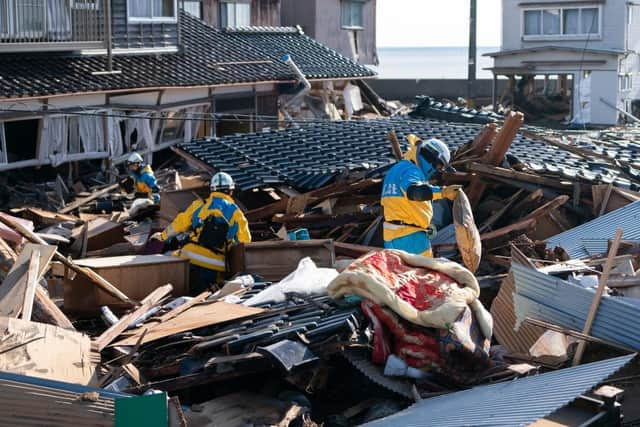Japan earthquake: How natural disaster could have been far worse without century of investment and earthquake proofing
As the world celebrated the start of a new year, Japan was left reeling after an earthquake of 7.6 magnitude devastated a picturesque coastal community – and sparked the country’s first major tsunami warning in 13 years.
Images show properties on the northern tip of Ishikawa's Noto peninsula literally uprooted and cars crushed like tin cans. At least 84 people have been killed and around 50 more are missing, while thousands more have been evacuated from their homes.
Advertisement
Hide AdAdvertisement
Hide AdYet, while undoubtedly devastating, the impact of the disaster is a stark contrast to the aftermath of a similar-sized earthquake that rocked southern Turkey and north-west Syria almost a year ago.


More than 55,000 people died in the quake, which was just marginally higher than the recent one in Japan – at 7.8 – with tens of thousands of people still displaced from their homes. Eleven months on, humanitarian organisations are still dealing with the fall-out.
Both regions are susceptible to regular earthquakes. In Japan, four of the earth’s tectonic plates meet, while Turkey is located on the Anatolian plate, which is being squeezed westward by the northward collision of two other plates.
Yet the difference in the outcome of the two disasters is, essentially, due to wealth, which allows long-term planning and the financial resources to earthquake-proof buildings.
Japan’s New Year’s Day quake came almost exactly 100 years after huge swathes of Tokyo were flattened and more than 140,000 people killed in what became known as the Great Kanto Quake – a disaster that shaped the future of the country’s earthquake response for the coming century.
The event, on September 1, 1923, prompted a major revolution in building regulations, particularly in Tokyo, which is one of the biggest and most built-up cities in the world. Any new buildings were, from then on, required to be reinforced with steel and concrete, while wooden buildings had to have thicker beams.
Regulations have been updated since then every time a major seismic event occurred in Japan, with around 87 per cent of the buildings in Tokyo now believed to be able to withstand strong earthquakes. Many are designed to be flexible enough to move and sway during a quake, meaning they are unlikely to collapse. By contrast, many of the buildings in Syria and Turkey, especially those in Turkey constructed before 2000, were vulnerable to “pancaking”, where multi-storey buildings essentially fall flat.
Since 1960, September 1 – the day of the Great Kanto Quake – has been designated by the Japanese government as Disaster Prevention Day – a day of remembrance and to prepare for major natural disasters, including tsunami and typhoons. A smartphone warning system alerts Japanese citizens to potential seismic activity, allowing people in affected areas to evacuate.
Advertisement
Hide AdAdvertisement
Hide AdIn March 2011, the biggest earthquake ever to hit the country – measuring nine on the Richter scale and the fourth biggest earthquake ever recorded in the world – killed more than 18,000 people and triggered nuclear plant meltdowns in Fukushima. The deaths, however, were mainly caused by the resulting tsunami, rather than the collapse of buildings, demonstrating the benefits of the investment in earthquake-proofing buildings.
What is not fair is those in Syria and Turkey could not also benefit from modern engineering.
Comments
Want to join the conversation? Please or to comment on this article.
